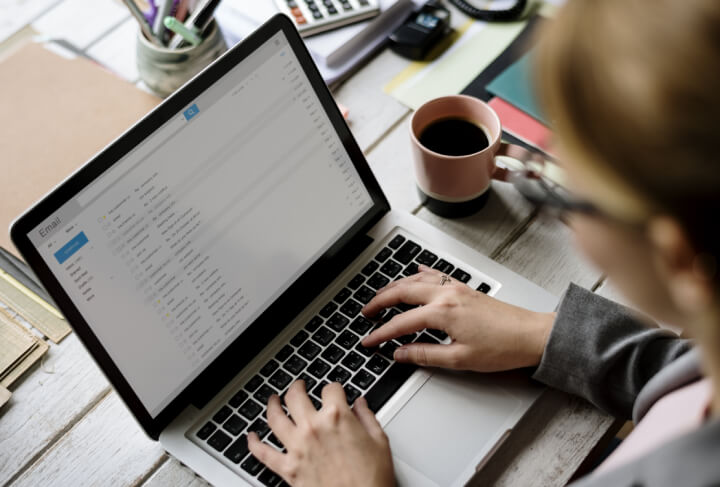You recently applied for a position that you’re really excited about. You know you’re qualified, and the responsibilities and the company culture seem like just what you’ve been searching for.
The next day, you eagerly check your inbox—and there’s nothing. You compulsively refresh your email. And, a week later? There’s still no news from that employer.
You’re beginning to get nervous. You want to do everything you can to separate yourself from the competition and increase your chances of landing that job. So, you decide to send a follow up email.
When done well, a follow up email after job application can demonstrate your commitment, reinforce your skills, and highlight your enthusiasm about that particular job and company.
But, when these emails are done poorly? Well, they can actually work against you and get your application tossed straight into the trash can. Cue the horror movie soundtrack.
What do you need to know to send a follow up email that impresses that employer and hopefully gets your resume moved to the “to be interviewed” pile? We’re dishing out all of the details you need.
Want to learn more?
Take your soft skills to the next level with our comprehensive (and free) ebook!
When should you follow up?
One of the biggest questions that job seekers have about following up on their job applications is exactly when they should check in.
You probably know by now that employers don’t always share your same sense of urgency about the job hunt. While a week stretches on for you, it whizzes right by for an employer who’s busy weeding through resumes and juggling a bunch of other important tasks.
You want to be respectful, but you don’t want to be so hands-off that you miss the hiring window. At the same time, you also don’t want to seem like an over-eager pest.
Confused? It’s a narrow line to walk, that’s for sure. Here are two key tips to keep in mind when determining when it’s an appropriate time to check in.

Pay attention to the hiring timeline
Many companies are actually pretty upfront about their application timelines in an effort to give candidates reasonable expectations.
Before sending any sort of email, head back to the job description to see if there’s any information there that you should be aware of.
For example, if they state that applications don’t close until a certain date, it’s not worth checking in on your own status before then. They probably won’t get in touch with any applicants until all of the submissions are in.
Make sure to look for any of these details that the employer has already shared. That will not only help calm your own nerves, but also give you the information you need so that you don’t ask the employer something that’s already been clearly answered.
Wait approximately two weeks
What should you do if there’s no information about how long you should expect to wait?
Well, I have news for you: 24 hours is not a reasonable amount of time to expect to hear back. The general rule of thumb is that you should wait about two weeks after submitting your application before following up.
I know—that seems like ages when you’re eager to hear any sort of update. But, doing so will show your respect for that employer’s time (and help you avoid seeming obnoxious).
How should you follow up?
You’ve waited a reasonable amount of time, and you’re ready to check in with that employer. Uhhh...now what? How do you follow up? What should you say?
In terms of how you should follow up, check in with that employer via email, rather than a phone call or through social media.
One important caveat here: Of course, if the company has outlined specific rules for where you should direct questions or how you can check in on the status of your application (such as an online dashboard), make sure that you follow those instructions rather than assuming that you’re above the rules.
Now, let’s cover a few tips for how to actually write a polite and professional follow up email after a job application.
1. Be enthusiastic and polite
You haven’t heard anything from that employer, and that has you feeling slightly irritated. That makes it easy to point the finger and start your email with something like, “Since I haven’t heard from you…”
Trust me—you don’t want to do that. In fact, head far in the opposite direction. Be polite and understanding. Express your excitement about the company and the opportunity.
That sets a way better impression than storming into their inbox feeling entitled to a response.

2. Emphasize your value
Between the application, your resume, and your cover letter you have pretty limited real estate to prove your value. Fortunately, this follow up message is another chance to (briefly!) highlight what you bring to the table.
Dedicate a line or two to refreshing that employer on why you’re a good fit for that position. That added effort certainly can’t hurt!
3. Ask about the timeline (rather than your candidacy)
I know—you’re tempted to write an email that essentially asks if you landed the job, or at least an interview. But, that tactic seems way too pushy and presumptuous.
Instead of asking about your candidacy specifically, check in on the timeline of the hiring process. That’s a far less demanding question that still gets you the information you really want.
4. Be brief
This email is your chance to get some personal contact with that employer and really make an impression. So, that means you should tell them everything they could possibly want to know about you, right?
Not exactly. I can understand the temptation to cram as much as you can into that email. But, in reality, it’s better to keep things short.
That employer is busy (and likely drowning in applications), so remember that they don’t have time to read your 900-word follow up email. Be as concise as possible.
5. Say, “Thank you”
When you wrap up your email, make sure that you’re gracious. I know—nothing great has happened for you yet. But, their time and consideration are still worthy of your gratitude. So, don’t forget the heartfelt, “Thank you!”
6. Read through your email (and then read it again)
You spent hours combing through your resume to make sure it was totally error free. Do you really want to follow that up by sending an email that’s riddled with typos?
Definitely not. While an email doesn’t have the same level of formality as your resume, it’s still a representation of you and your attention to detail.
Needless to say, it’s important that you proofread—and proofread carefully. Read through your email several times, and then read it through once more from bottom to top. That will force your brain to focus on each sentence individually, which means you’re far more likely to catch any mistakes.
Put it all together: A follow up email sample
There you have it—six key tips for a successful follow up email. So, what does a message look like when you put all of those tips together? Here’s an example of a polite and polished follow up email after a job application.
Hi Susan,
I hope you’re doing well!
My name is Kat Boogaard, and I recently applied for your Content Marketing Associate role at XYZCompany.
Having spent the past four years crafting content strategies and producing engaging articles for a variety of health and wellness-focused clients, I’m confident that I could offer a lot of value in this position.
With that in mind, I’m checking in on your hiring timeline for this position. Do you know when you’ll be making a decision about which candidates will be moving to the interview stage?
I’m really excited about the role and the opportunity to be a part of the inspiring work that XYZCompany is doing to push the healthcare industry forward.
Thanks so much for your time and consideration, Susan. I’m wishing you and the entire XYZCompany team nothing but the best!
Looking forward to hearing from you,
Kat
But...what if you still don’t hear anything?
Here’s the bad news: even if you send the most perfect follow up email you could’ve come up with, you still might not hear anything back from that employer.
Then what? If you still haven’t received a response a week or two after sending your first follow up message, feel free to send another one.
If that second email goes unanswered? I know this probably isn’t what you want to hear, but at that point, it’s probably better to move onto pursuing other roles.
Think about it this way. You want to find an employer who’s equally as excited as you—who’s enthusiastic about what you offer. Chances are a company that you have to repeatedly chase down probably isn’t going to be a place you enjoy working in the long run.
Sending a follow up email after a job application: do it right
Needing to wait to hear back about your job application feels like a rare form of torture. Fortunately, sending a follow up email after job application can keep your name on the radar and help you forge more of a personal connection with that employer.
Keep in mind that while an email is what you should use to directly follow up, it’s not your only option for interacting with that dream employer of yours. Connect with the hiring manager or department head on LinkedIn. Follow the company on social media and engage with some of their posts.
Those efforts to demonstrate your interest—combined with the polished follow up email we outlined above—will hopefully get your application moved to the top of the pile. Good luck!
As you continue your job hunt, explore these GoSkills courses to help boost your resume, and set yourself apart from the competition.
Gain the soft skills employers want
Start learning for free with GoSkills courses
Start free trial



